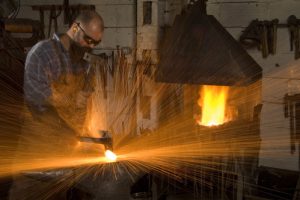EFFECTS OF WELDING HEAT
During the process of welding, the metal is heated over a range of temperature up to fusion and then allowed to cool. Heating and cooling causes metallurgical and mechanical effects on the metal pieces being welded. The region of the base metal which is affected by metallurgical change due to the welding heat is called the heat affected zone. In this zone, the metal has been heated and cooled through a range of temperature great enough to cause changes in the structure of the metal. The amount of change may be controlled by using the suitable welding processes. Sometimes, the original properties may be restored by heat treatment after welding. Although the mechanical strength of weld metals is at least equal to that of the base metal but the metallurgical changes can reduce greatly the associated properties of the joint particularly for shock and fatigue.
Mechanical effects of welding heat are the distortion and the residual stress resulting from welding. The magnitude of these effects depends on the factors of design and welding procedure. But the effects will always be present to a certain extent in any structure fabricated or repaired by non-pressure welding. Because of expansion and contraction of the heated portion the distortion and residual stresses set up. The base metal heated locally will expand and up set owing to the restraint imposed by tile surrounding cold metal. This upset portion of the base metal will contract on cooling beyond its original dimensions and thereby setup internal stresses causing distortion. If the pieces being welded are not tree to move, high residual stresses will be formed which may cause cracking during welding.
The residual stresses also reduce load carrying capacity of the structure. The residual stresses may be relieved by heat treatment. Preheating the whole structure is helpful to reduce residual stresses. Certain procedures and proper welding sequences are also used in removing the distortion and internal stress. It is to be noted that the flow of heat in the weld zone is highly directional towards the adjacent cold metal, which produces columnar grains at right angle to the fusion line. The columnar structure is a characteristic of the metal of single pass welds. Thus the original structure consisting of ferrite and pearlite in slabs is changed to another microstructure. The composition of the first crystal which form a molten alloy may quite different from the composition of the liquid, but as the freezing proceeds, the crystals readjust their composition to that of the initial liquid alloy in order to satisfy the condition of equilibrium. The weld metal when it is in the molten state can dissolve in ore gases, which come into contact with it, like oxygen, nitrogen and hydrogen. But as the metal cools it looses its dissolving capacity and the dissolved gases become free from the metal creating gas pockets and porosity in the final weld.
Welding processes widely used in the industry include oxy-acetylene, manual metal arc or shielded metal arc, submerged arc, gas metal arc, gas tungsten arc welding, resistance welding, thermit welding and cold pressure welding. Most of these processes have special fields of influence like resistance welding is popular with the automobile industry, thermit welding for joining rails. Gas metal arc welding is particularly suited for welding of low carbon steel structures as also welding of stainless steels and aluminium. It is more popular in aeronautical and nuclear industries. Submerged arc welding is used for ship building. Cold pressure welding is preferred by food processing industry. However, Arc welding and oxyacetylene welding, processes are the general purpose processes with a wide range of applications. Some of the typical applications of welding include the fabrication of ships, pressure vessels, automobile bodies, off-shore platform, bridges, welded pipes, sealing of nuclear fuel and explosives, etc. The knowledge of welding is much essential to make welded fabrications a success.
Source A Textbook of Basic Manufacturing Processes and Workshop Technology by Rajender Singh.
